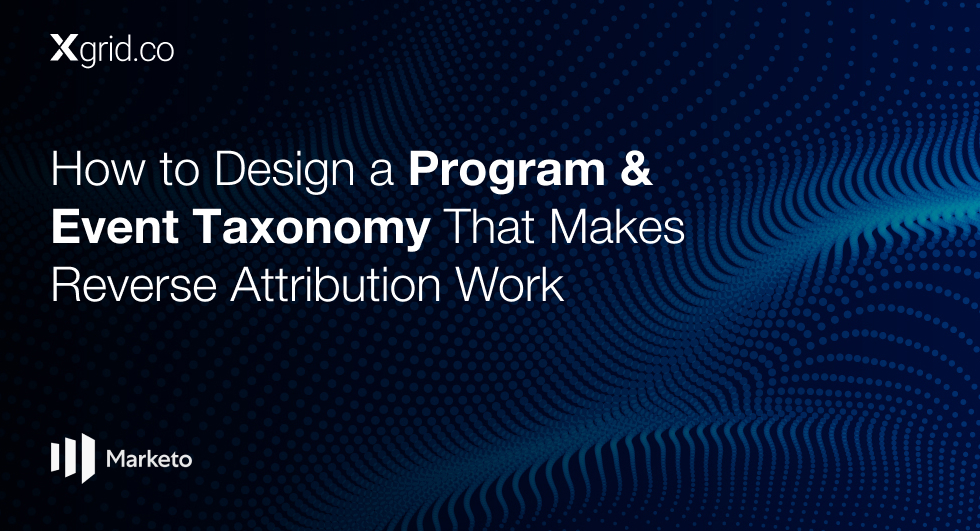Why Reverse Attribution Saves You Money Compared to Traditional Marketo Attribution
If you’ve ever explored attribution modeling in Marketo, you know the usual recommendation: use Revenue Cycle Modeler (RCM) and Revenue Cycle Analytics (RCA). On paper, they’re powerful. In practice, they’re expensive, complex, and slow to implement.
That’s why more teams are turning to reverse attribution—a leaner, faster way to prove marketing’s impact on the pipeline without the overhead of traditional attribution methods.
In this post, we’ll break down why reverse attribution saves you money compared to traditional Marketo attribution—and how you can use it to deliver executive-ready insights in just weeks, not months.
What Is Reverse Attribution in Marketo?
Reverse attribution is the process of reconstructing marketing influence after opportunities are already created or even closed. Instead of needing a perfect model set up in advance, it lets you go back, stitch together touches, and prove which campaigns influenced revenue.
Key benefits:
- Works retroactively, so you can analyze the last 2–3 quarters right away.
- Doesn’t require RCM or RCA licenses.
- Runs off data you already have in Marketo and Salesforce.
In other words, it delivers board-ready proof of marketing impact without the heavy investment traditional attribution demands.
The True Cost of Traditional Attribution (RCM & RCA)
Marketo’s Revenue Cycle Modeler and Revenue Cycle Analytics have two big price tags:
- Licensing Costs
- RCA is a paid add-on, and depending on your contract, it can run into tens of thousands annually.
- If you’re not already on Adobe’s higher-tier plans, RCM/RCA can balloon your budget fast.
- Implementation Costs
- Building and maintaining an RCM requires weeks (or months) of admin time.
- You’ll likely need RevOps consultants or Adobe-certified experts—another line item in the budget.
- Complex setup = more risk of sync issues between Marketo and Salesforce.
Even after all that, leadership often finds RCA dashboards hard to read, slow to update, or disconnected from board-level narratives.
Why Reverse Attribution Is More Cost-Effective
Here’s where reverse attribution wins:
1. No Expensive Add-Ons
Reverse attribution uses Marketo + Salesforce data only—no RCM or RCA licenses required. That alone can save teams five figures a year.
2. Fast Implementation
Instead of a months-long rollout, reverse attribution can be implemented in 2 weeks with a structured plan:
- Export program data, opportunity contact roles, and activity logs.
- Standardize UTMs and fix missing campaign members.
- Map success statuses and run validations.
- Deliver influenced pipeline and closed-won attribution reports.
Time is money, and reverse attribution pays off faster.
3. Lean but Reliable Data Model
By focusing on clean taxonomy and success statuses, reverse attribution avoids the bloat of RCM’s over-engineered stages. You only track what matters:
- Webinars attended
- Demo requests
- Whitepaper downloads
- Key page visits (pricing, contact, trial)
- Newsletter clicks
- Chatbot conversions
No wasted effort inflating influence with vanity metrics.
4. Executive-Ready ROI Stories
Reverse attribution isn’t just cheaper—it’s more persuasive. Instead of technical funnel reports, you deliver clear narratives like:
- “This webinar influenced $3.2M in pipeline and closed 8 deals in 90 days.”
- “Decision-makers who engaged with trial offers had a 2.3x higher close rate.”
That’s the kind of attribution leadership actually cares about.
Reverse Attribution vs Traditional Attribution: A Side-by-Side
Why This Matters Now
Boards and executive teams want fast, credible proof that marketing is influencing revenue. They don’t want to hear about Marketo sync errors, broken stages, or expensive add-ons that take months to deliver.
Reverse attribution offers:
- Immediate ROI visibility
- Low friction buy-in from CMOs and CFOs
- A clear win for marketing teams under budget pressure
It’s demand gen surgery before your next board review—fast, precise, and high impact.
Final Thoughts
Traditional attribution in Marketo has its place, but for most companies, it’s too costly, too slow, and too complex.
Reverse attribution, on the other hand, gives you:
- A lean, affordable setup.
- Insights you can trust in just weeks.
- Board-ready narratives that prove marketing’s value.
If you want to save money on attribution while actually winning executive trust, reverse attribution is the smarter play.





